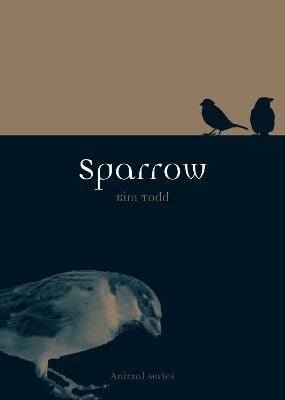
Sparrow
Seiten
2011
Reaktion Books (Verlag)
978-1-86189-875-3 (ISBN)
Reaktion Books (Verlag)
978-1-86189-875-3 (ISBN)
Award-winning writer Kim Todd explores the complex history, biology and literary tradition of the cheeky and ubiquitous sparrow, including coverage of the nineteenth-century 'Sparrow War' in the United States over the sparrow's introduction which led to decades of discussion about invasive species.
Innocent. Invader. Lover. Thief. Sparrows are everywhere, in many guises. They are cherished pets, subject of elegies by Catullus and John Skelton, listed as 'pretty things' in Sei Shonagon's Pillow Book. They're grimy, urban vermin with shocking manners, so reviled that during the 1950s Mao placed them on the list of 'Four Pests' and ordered the Chinese people to kill them all. In many countries they are appallingly successful non-natives, attacking indigenous birds and ravaging ecosystems. Able to live in the Arctic and the desert, from Beijing to San Francisco, the house sparrow is the most widespread wild bird in the world. In Sparrow, award-winning science and natural history writer Kim Todd explores the complex history, biology and literary tradition of this bird that embodies the word 'common'. In literature, the New Testament claimed that not a sparrow falls without God noting it; the idea of the precious sparrow developed from Hamlet to twentieth-century gospel hymns; the bold, defiant sparrow appears in many folk and fairy tales.
The author explores Old World sparrows, like the house sparrow, which can nest in a garage or in an airport, and New World sparrows, which often stake their claim to remote islands or meadows in the high Sierra. Todd looks at the nineteenth-century 'Sparrow War' in the USA - a battle over the sparrow's introduction - which set the stage for decades of discussions of invasive species. She examines the ways in which sparrows have taught us about evolution, and the recent decline of house sparrows in cities globally. This disappearance of a bird that seemed hardwired for success remains an ornithological mystery. With lush illustrations, ranging from early woodcuts and illustrated manuscripts to contemporary wildlife photography, this is the first book-length exploration of the natural and cultural history of this cheeky and ubiquitous bird.
Innocent. Invader. Lover. Thief. Sparrows are everywhere, in many guises. They are cherished pets, subject of elegies by Catullus and John Skelton, listed as 'pretty things' in Sei Shonagon's Pillow Book. They're grimy, urban vermin with shocking manners, so reviled that during the 1950s Mao placed them on the list of 'Four Pests' and ordered the Chinese people to kill them all. In many countries they are appallingly successful non-natives, attacking indigenous birds and ravaging ecosystems. Able to live in the Arctic and the desert, from Beijing to San Francisco, the house sparrow is the most widespread wild bird in the world. In Sparrow, award-winning science and natural history writer Kim Todd explores the complex history, biology and literary tradition of this bird that embodies the word 'common'. In literature, the New Testament claimed that not a sparrow falls without God noting it; the idea of the precious sparrow developed from Hamlet to twentieth-century gospel hymns; the bold, defiant sparrow appears in many folk and fairy tales.
The author explores Old World sparrows, like the house sparrow, which can nest in a garage or in an airport, and New World sparrows, which often stake their claim to remote islands or meadows in the high Sierra. Todd looks at the nineteenth-century 'Sparrow War' in the USA - a battle over the sparrow's introduction - which set the stage for decades of discussions of invasive species. She examines the ways in which sparrows have taught us about evolution, and the recent decline of house sparrows in cities globally. This disappearance of a bird that seemed hardwired for success remains an ornithological mystery. With lush illustrations, ranging from early woodcuts and illustrated manuscripts to contemporary wildlife photography, this is the first book-length exploration of the natural and cultural history of this cheeky and ubiquitous bird.
Kim Todd is Assistant Professor of English and Creative Writing in the School of Humanities and Social Sciences, Penn State Erie, The Behrend College. Her book Tinkering with Eden? A Natural History of Exotics in America (2001) was the winner of the Sigurd Olson Nature Writing Award. She is also the author of Chrysalis: Maria Sibylla Merian and the Secrets of Metamorphosis (2007).
| Reihe/Serie | Animal Series |
|---|---|
| Zusatzinfo | Illustrations |
| Verlagsort | London |
| Sprache | englisch |
| Maße | 135 x 190 mm |
| Gewicht | 318 g |
| Themenwelt | Sachbuch/Ratgeber ► Natur / Technik ► Natur / Ökologie |
| Sachbuch/Ratgeber ► Natur / Technik ► Naturführer | |
| Sozialwissenschaften ► Soziologie | |
| ISBN-10 | 1-86189-875-4 / 1861898754 |
| ISBN-13 | 978-1-86189-875-3 / 9781861898753 |
| Zustand | Neuware |
| Haben Sie eine Frage zum Produkt? |
Mehr entdecken
aus dem Bereich
aus dem Bereich
über 500 faszinierende Gesteine, Minerale, Edelsteine und Fossilien
Buch | Hardcover (2023)
DK Verlag Dorling Kindersley
CHF 39,90
Familien und Gattungen einheimischer Pflanzen
Buch | Hardcover (2022)
Haupt Verlag
CHF 67,95
vollständig aktualisierte Neuausgabe mit den zusätzlichen …
Buch | Softcover (2023)
Westend (Verlag)
CHF 30,80


